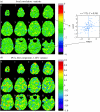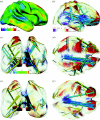Comparing functional connectivity via thresholding correlations and singular value decomposition
- PMID: 16087436
- PMCID: PMC1854921
- DOI: 10.1098/rstb.2005.1637
Comparing functional connectivity via thresholding correlations and singular value decomposition
Abstract
We compare two common methods for detecting functional connectivity: thresholding correlations and singular value decomposition (SVD). We find that thresholding correlations are better at detecting focal regions of correlated voxels, whereas SVD is better at detecting extensive regions of correlated voxels. We apply these results to resting state networks in an fMRI dataset to look for connectivity in cortical thickness.
Figures




References
-
- Baumgartner R, Ryner L, Richter W, Summers R, Jarmasz M, Somorjai R. Comparison of two exploratory data analysis methods for fMRI: fuzzy clustering vs. principal component analysis. Magn. Reson. Imaging. 2000;18:89–94. - PubMed
-
- Cao J, Worsley K.J. The geometry of correlation fields, with an application to functional connectivity of the brain. Ann. Appl. Probab. 1999;9:1021–1057.
-
- Cordes D, Haughton V, Carew J.D, Arfanakis K, Maravilla K. Hierarchical clustering to measure connectivity in fMRI resting-state data. Magn. Reson. Imaging. 2002;20:305–317. - PubMed
-
- Gonçalves M.S, Hall D.A. Connectivity analysis with structural equation modelling: an example of the effects of voxel selection. NeuroImage. 2003;20:1455–1467. - PubMed
-
- Goto R, et al. Normal aging and sexual dimorphism of Japanese brain. NeuroImage. 2001;13(Suppl. 1):794. - PubMed
Publication types
MeSH terms
LinkOut - more resources
Full Text Sources
Medical

